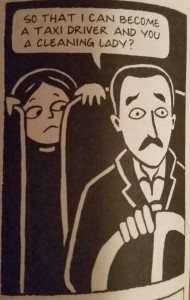Hello readers!
This week on ASTU, we continued talking about the book Persepolis written by Marjane Satrapi. We not only discussed the style of the book in depth but also linked the style of the drawing to the child’s view of violence and trauma.
The comic style of the book made it approachable and easy to read, she drew it in the view of a child and the child-like language used made it easily relatable. Despite the simplistic drawing technique used, what Satrapi is trying to convey to us readers are far more dark and not for the faint hearted. She tries to express her anger towards war, her hatred towards violence and her sympathy towards the innocents that died during the protest. Satrapi purposely drew out how she perceived all the violence as a child and how she imagined it to look. Take the mass murder scene as an example, everything is so neat and tidy, there is no blood nor broken limbs shown in the panel. As a reader, we know that the actual scene would be far more bloody, this gave us readers the opportunity to picture how it would actually look like. In another words, it is also because of the book’s simplistic drawing style that enabled us to focus on the main idea of violence. If the panel is filled with colour or patterns, those effects would over shadow the main idea of violence. Keeping the colour black and white give it a sense of seriousness which helps deliver her story and keep the readers in mind that she is talking about a serious issue.
Another feature I would like to point out is how simple the heading of each chapter is. Marjane Satrapi purposely named the chapter after commonly found things in her daily life in her childhood. For example the veil, the bicycle, the key…. This shows a child remember events by linking their memories to an everyday object, and each object have a story of its own. Every chapter, she will bring out a deeper meaning using the object mentioned in the heading as a lead. The fact that even the most common objects have a sad story behind it suggested that she has a painful childhood.
What I love about Marjane Satrapi’s book Persepolis is how well planned the book is, every panel and heading is purposely drawn or in a particular way to bring out a deeper meaning. I find this comic book an amazing depiction of the Islamic Revolution, it gave us insight of what is happening during that time.
Thank you for reading and I hope my piece is a delight to read!
By Rachel Lam

